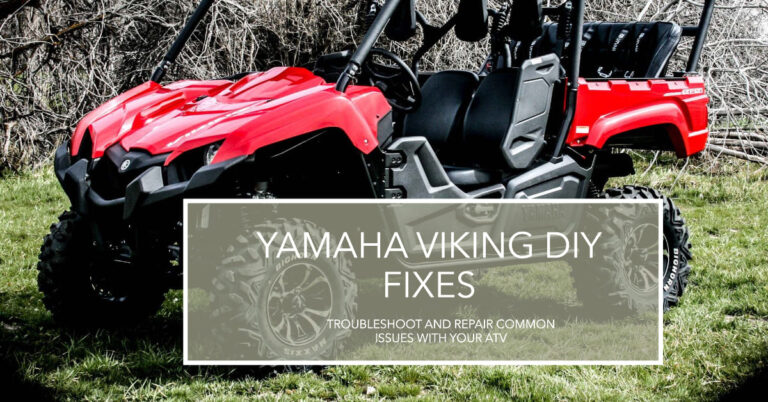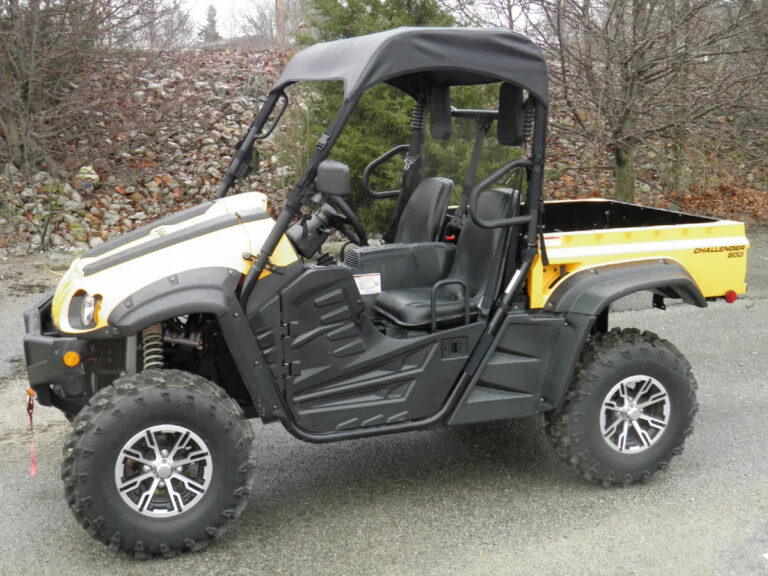Kawasaki Mule Pro MX Problems: Troubleshooting Guide

Experiencing issues with your Kawasaki Mule Pro MX utility terrain vehicle? You’re not alone. As one of Kawasaki’s most popular UTV models for both recreation and rugged utility use, the Mule Pro MX is bound to have some common problems arise after months or years of use. But how do you know what’s causing the problems and how to fix them?
That’s exactly what this complete troubleshooting guide will cover.
We’ll dive into the most common Kawasaki Mule Pro MX problems owners experience, from engine troubles to suspension issues. You’ll learn how to diagnose problems through key symptoms, narrow down the root cause, and find solutions to get your Mule back up and running smoothly again. Whether it’s loss of power, electrical gremlins, or transmission slippage, we’ve got you covered.
Read on as we uncover common issues with the Mule Pro MX’s:
- Powerplant and drivetrain
- Fuel and electrical systems
- Braking and suspension parts
- And more
Armed with the knowledge this guide provides, you’ll be prepared to handle nearly any problem your Mule can throw at you. Let’s get started!
Table of Contents
Background On The Kawasaki Mule Pro MX
Before diving into troubleshooting, let’s provide some quick background on Kawasaki’s Mule Pro MX. This two-seat utility UTV was introduced in 2015 as an upgrade over the standard Mule 4010 with more rugged capabilities.
Key features include:
- 695cc two-cylinder fuel injected engine
- Continuously Variable Transmission (CVT)
- On-Command 4WD/2WD
- Double wishbone suspension
- Disc brakes with twin piston calipers
- Steel cargo bed with 400lb capacity
The muscular 695cc engine delivers plenty of low end torque while the CVT transmission enables smooth acceleration and optimal efficiency. With its ample power, rugged suspension, and cargo hauling strengths, it’s no wonder the Mule Pro MX has become a top choice for both work and play.
However, even well-engineered side-by-sides like the Mule are susceptible to issues over time. Next we’ll cover what owners report as the most prevalent Mule Pro MX problems and how to diagnose them.
Common Kawasaki Mule Pro MX Problems
These are some of the most reported issues with the Mule Pro MX:
Engine Problems
As the powerplant of the Mule Pro MX, it’s no surprise the engine often experiences common problems after years of use:
Loss of Power
Over time, gradual power loss is typical as engine components wear. Some common causes include:
- Clogged air filter or fuel filter restricting airflow and fuel delivery
- Failing fuel pump not delivering sufficient fuel pressure
- Dirty fuel injectors not atomizing fuel properly
- Loss of compression due to worn piston rings or leaking head gasket
Overheating
Engine overheating can stem from:
- Low coolant levels
- Damaged radiator fins restricting airflow
- Leaking hoses
- Failed water pump or thermostat
- Excess debris built up around coolant system
Excessive Oil Consumption
Burning too much oil? Look for these culprits:
- Worn valve guide seals and piston rings allowing oil to leak past
- Clogged air filter causing incorrect fuel mixture and oil burn
- Damaged or clogged PCV valve
Knocking/Pinging
Audible knocking or pinging under load indicates:
- Engine overheating
- Poor quality/incorrect octane fuel
- Carbon buildup in combustion chamber
- Incorrect ignition timing typically due to camshaft position sensor issues
Hard Starting
Difficulty starting, long cranking time, or intermittent no-start:
- Weak battery unable to spin starter fast enough
- Corroded or loose battery connections
- Fuel pump failure or relay problem
- Clogged fuel filter
- Faulty spark plugs, wires, or coils
Misfires
Sporadic misfires or uneven power delivery point to:
- Damaged spark plugs/wires
- Weak coil packs
- Vacuum leaks throwing off fuel mixture
- Failing fuel injectors clogging or not spraying correctly
Pay attention for any of these symptoms associated with engine problems. When diagnosed early, many can be resolved with basic maintenance and minor repairs.
Fuel System Problems
Since the Mule Pro MX is fuel injected, issues with the fuel system components can arise:
Fuel Pump Failure
The in-tank fuel pump is electromagnetic and operated by the ECU. Gradual power loss or no-start issues often trace back to a dying fuel pump unable to deliver adequate pressure.
Clogged Fuel Filter
The filter situated after the pump screens debris from fuel before it reaches the injectors. A restricted filter impedes flow.
Faulty Fuel Injectors
Injectors are high precision components that spray atomized fuel into the cylinders. Over time, their tips can clog with deposits or they can fail electrically leading to misfires.
Vacuum Leaks
Cracks in intake piping, a loose intake manifold, or failing PCV valve can create vacuum leaks. This introduces unmetered air, throwing off the engine’s air/fuel ratio and potentially causing rough running.
Monitor your Mule for symptoms of fuel starvation like surging, loss of power, or hard starting as this indicates a problem with fuel delivery.
Electrical Gremlins
Like most modern vehicles, the Mule Pro MX is packed with electrical components that can sometimes cause frustration:
Battery Issues
Batteries gradually lose their ability to hold a charge. This will manifest as slow cranking, dimming lights, or the Mule not starting. Time for a new battery.
Faulty Alternator
The alternator charges the battery while driving. If the alternator fails, the battery discharges rapidly. Signs include:
- Battery light coming on with engine running
- Ammeter showing zero charge
- Battery draining with electronics on despite engine running
Blown Fuses
All Mules have a power distribution module that routes electricity through fuses to components. Shorts or overloads can blow fuses interrupting operation.
Starter Problems
A high pitch grinding, slow cranking, or click with no crank generally means a damaged starter motor needing repair or replacement.
Wiring Harness Damage
Rodents love chewing through UTV wiring harnesses. Inspect under seats and hood for signs of damage. Exposed or shorted wires will cause all sorts of electrical faults and frustration!
Meticulously tracing electrical problems takes patience but methodically checking connections, harnesses, and components will uncover the issue.
Transmission Troubles
The Mule Pro MX uses a continuously variable transmission (CVT) providing infinite gear ratios. Like other transmissions, these eventually have problems including:
Slipping/Belt Burning
The CVT uses a belt squeezed between a drive and driven pulley to transmit power. Worn drive belt material leads to slippage under load. Burning rubber smells indicate a worn belt.
Delayed Engagement
Slow or delayed engagement when shifting into gear can be early signs of worn belt or clutch components.
Noisy Operation
Gear grinding noises usually stem from damaged drive/driven clutch teeth. Bearing noises point to worn bearing failure.
Fluid Leaks
Inspect seals, gaskets, and hoses for leaks. Low fluid levels will accelerate transmission damage. Top off with manufacturer approved CVT fluid.
Transmission issues lead quickly to catastrophic failure so address any symptoms immediately. Proper servicing is key for long CVT life.
Braking Problems
Reliable braking is critical for controlling a side-by-side, especially downhill. Some brake issues include:
Soft/Spongy Pedal
Air trapped in the hydraulic lines or leaking calipers will cause a soft brake pedal with diminished stopping power. Bleed the system to purge any air.
Pulling to One Side
Uneven pad material wear results in front or rear braking bias pulling the Mule to one side. Inspect pads and rotors for excessive wear.
Squealing/Grinding
These noises signal contaminated pad material or worn out brake pads. Inspect pad thickness and replace if under 3mm.
Uneven Wear
One brake pad wearing faster indicates a sticking caliper piston on that wheel. Pistons should retract evenly. Service calipers if sticking.
Monitor pad thickness regularly and flush brake fluid yearly to avoid braking issues.
Suspension Problems
The double A-arm suspension soaks up rough terrain but needs regular inspection:
Shock Oil Leaks
Worn seals on the shock absorbers will lead to oil seepage. Visually inspect for any dampness around shafts and seal areas.
Worn Ball Joints
Inspect ball joints for signs of cracking, pitting, or wear. Grab the control arms and check for excessive play indicating worn joints.
Uneven Tire Wear
Check tire tread depth across all four tires. Uneven wear usually means faulty shocks or misaligned wheels. Rotate tires regularly to prevent uneven wear patterns.
Don’t ignore any sagging, bouncing, or bottoming out issues which signal worn-out shocks. Maintain proper tire pressure and realign wheels if needed.
Diagnosing and Repairing Common Mule Pro MX Problems
When issues inevitably crop up with your Mule, here are some handy tips for diagnosing and repairing the most common problems:
Start with the Basics
Before assuming major failure, check the simple stuff first:
- Battery charged?
- Fresh fuel with no contaminants?
- Clean air filter?
- Proper tire pressure?
- Fluid levels full?
- Battery terminals clean and tight?
- Fuses intact?
Isolate the Problem
Pinpoint the specific system where the issue is occurring. Is it during starting, acceleration, braking, steering, etc?
Reproduction
Can you recreate the problem or does it happen randomly? Take notes of any patterns.
Visual Inspection
Look under seats, in cargo box, underbody, and engine bay for obvious issues like leaks, damage, wear, or loose parts. Let your eyes diagnosis!
Sensor Data
Many areas like engine, transmission, and battery have sensors reporting data to the ECU. Scanner tools can access this to isolate problems.
Common Sense Testing
Use logic and simple testing to further pinpoint. Examples – spray water on components to check for arching and electrical faults, use a fuel pressure gauge to test pump output, check if spark plugs are firing correctly.
Manufacturer Diagnostic Flowcharts
Consult your owner’s manual which often includes detailed flowcharts for diagnosing issues by symptom. Follow their step-by-step checks.
When in Doubt, Seek Professional Help
Some problems require advanced diagnostic computers and knowledge best left to dealership technicians. If you’re unsure, have a pro diagnose rather than guessing.
Preventing Future Problems
The best way to avoid major repairs and downtime is staying ahead of maintenance on your Mule Pro MX:
- Follow the factory maintenance schedule in your owner’s manual
- Inspect and lubricate suspension components
- Check engine oil, filters, fluids regularly
- Clean battery terminals and charge monthly if not used
- Wash dust/debris off radiator fins
- Check brake pads & rotor thickness
- Inspect belts, hoses, seals for cracks
- Check tire tread and air pressure
- Inspect wiring for rodent damage or wear
- Fix any oil leaks promptly
- Address unusual noises, smells, or symptoms immediately
No machine is problem-free. But diligent preventive maintenance will help your Mule Pro MX deliver years and miles of reliable fun and productivity.
Conclusion
Like any machine, the Mule Pro MX is susceptible to occasional issues. In this troubleshooting guide we’ve covered the most prevalent problems owners experience and how to diagnose and repair them.
Armed with this overview, you can address common Kawasaki Mule Pro MX problems with confidence. Reference your owner’s manual for factory specifications and maintenance procedures. For complex issues beyond DIY, consult a certified Kawasaki dealer.
Stay ahead on routine maintenance and enjoy the capabilities of your trusty Mule Pro MX for years to come! Let us know if you have any other problems arise not covered here. We aim to provide a thorough troubleshooting resource for Mule owners. Ride on!







